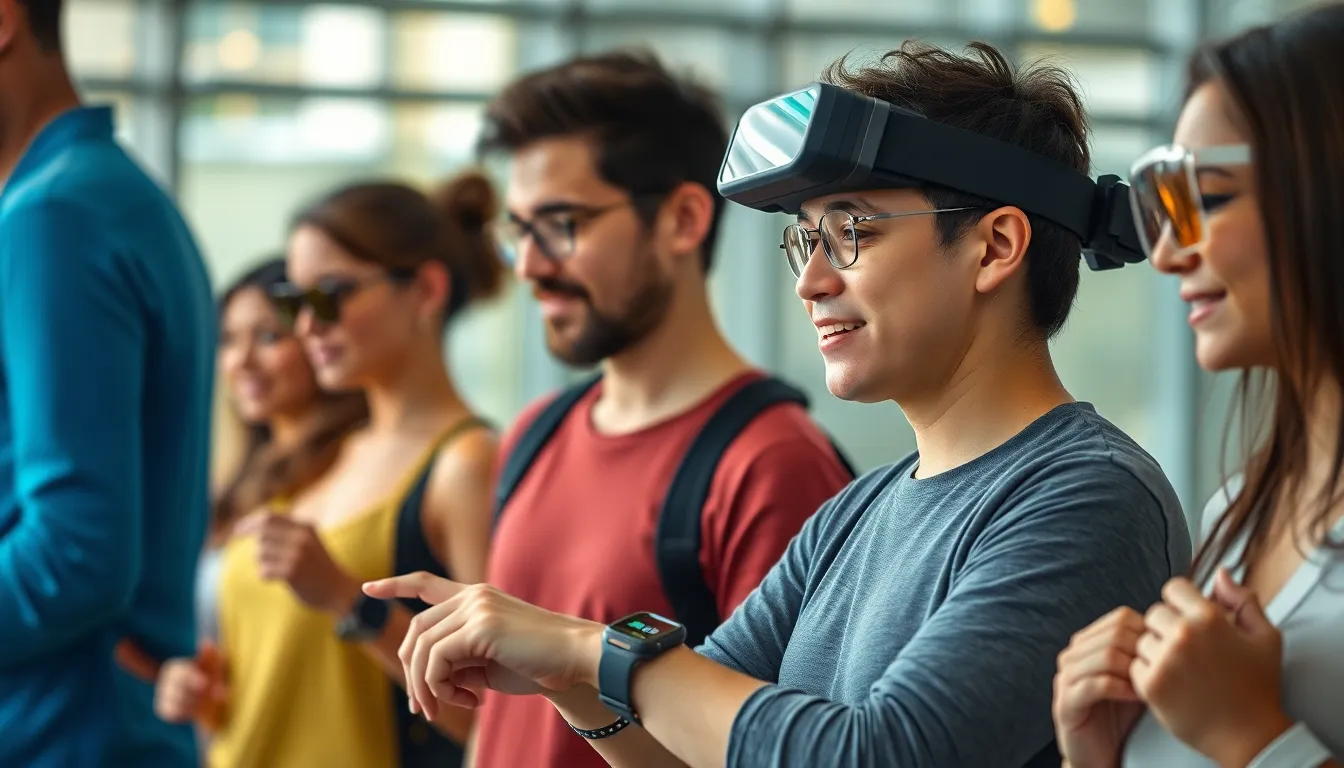Table of Contents
ToggleWearable technology is transforming the way people interact with the digital world. From fitness trackers to smartwatches, these devices seamlessly integrate into daily life, providing users with real-time data and insights. As technology advances, wearables are not just about convenience; they’re becoming essential tools for health monitoring, communication, and personal productivity.
With an increasing number of individuals embracing these gadgets, the market for wearable technology is booming. This surge reflects a growing awareness of the benefits these devices offer, from tracking physical activity to managing stress levels. Exploring the latest trends and innovations in wearable tech reveals how it continues to shape lifestyles and redefine personal health management.
Overview of Wearable Technology
Wearable technology encompasses a range of electronic devices designed to be worn on the body, often integrating various sensors and connectivity features. Devices such as fitness trackers, smartwatches, and smart glasses deliver real-time health metrics and communication capabilities.
Categories of Wearable Technology
- Fitness Trackers: Track physical activities like steps, calories burned, and sleep patterns.
- Smartwatches: Offer notifications, health monitoring, and apps for enhanced user interaction.
- Smart Glasses: Provide augmented reality experiences and hands-free information access.
- Health Monitors: Include specialized devices like ECG monitors and continuous glucose monitors for medical purposes.
Benefits of Wearable Technology
- Health Monitoring: Facilitates tracking of vital signs and health metrics, promoting proactive health management.
- Activity Tracking: Encourages users to maintain physical activity through data insights and reminders.
- Connectivity: Enhances communication by linking to smartphones, allowing users to receive calls and messages seamlessly.
Market Trends in Wearable Technology
- Growth Rate: The global wearable technology market is projected to reach $198 billion by 2025, reflecting significant consumer demand.
- Innovations: Integrations of advanced features such as AI for personalized insights and improved battery life are becoming commonplace.
- Diverse Applications: Expansion beyond fitness to include applications in healthcare, gaming, and workplace productivity.
Wearable technology transforms everyday experiences, offering tools that enhance health consciousness and digital connectivity. Its continuous evolution shapes consumer preferences and expectations in personal tech.
Types of Wearable Technology

Wearable technology encompasses various devices worn on the body, each designed for specific functions. This section explores the primary categories of wearable technology, focusing on their distinct features and uses.
Fitness Trackers
Fitness trackers monitor physical activities and provide data on metrics such as steps taken, calories burned, heart rate, and sleep patterns. These devices often feature sensors that track movement and use GPS for distance measurement. Popular models, like Fitbit and Garmin, enable users to set fitness goals, share achievements, and access coaching tips through companion apps.
Smartwatches
Smartwatches combine fitness tracking with enhanced communication capabilities. They display notifications from smartphones, offer app integrations, and allow users to respond to messages or calls directly from their wrist. Brands like Apple and Samsung lead the market, providing features such as customizable watch faces, voice commands, and health monitoring options like ECG and blood oxygen saturation measurements.
Augmented Reality Devices
Augmented reality (AR) devices overlay digital information on the real world, enhancing user experiences. Products like Microsoft HoloLens and Google Glass enable applications in areas such as education, training, and gaming. These devices integrate with other technologies, allowing users to interact with both virtual and physical environments, facilitating immersive learning and improved productivity.
Benefits of Wearable Technology
Wearable technology offers various advantages that enhance daily life, particularly in health, convenience, and connectivity. These benefits contribute to increased user adoption and market growth.
Health Monitoring
Health monitoring through wearable devices enables real-time tracking of vital signs and physical activities. Devices such as smartwatches and health monitors provide data on heart rate, sleep patterns, and calorie expenditure, improving individual health management. For example, continuous heart rate monitoring can help detect arrhythmias early, enabling timely medical intervention. Furthermore, fitness trackers encourage regular activity by setting daily goals and tracking progress, which fosters healthier lifestyle choices. Research shows that using wearables for health monitoring leads to an increase in physical activity levels by 30%.
Convenience and Connectivity
Wearable technology enhances convenience and connectivity through seamless integration with smartphones and other devices. Smartwatches allow users to receive notifications, answer calls, and access apps without needing to pull out their phones. This hands-free connectivity streamlines daily tasks and enhances productivity. Additionally, many wearables feature voice-activated assistants, providing instant access to information and services. The ease of managing daily responsibilities contributes to a more organized lifestyle, as users can monitor schedules and access reminders directly from their wrists.
The combination of health monitoring and enhanced connectivity illustrates the transformative power of wearable technology, making it an essential component of modern life.
Challenges of Wearable Technology
Wearable technology faces several challenges that impact user experience and overall adoption. Key issues include privacy concerns, battery life, and durability of the devices.
Privacy Concerns
Privacy concerns pose significant challenges for wearable technology. Many devices collect sensitive data, such as health statistics and location information, raising questions about data security. If companies don’t implement robust encryption and clear data handling practices, users’ personal information may be vulnerable to unauthorized access. Furthermore, consumers often lack understanding of how their data is used, resulting in skepticism about sharing information with wearable devices. Data breaches in the technology industry heighten these concerns, making consumers wary of adopting new wearables without transparency regarding data management policies.
Battery Life and Durability
Battery life and durability present considerable challenges for wearable technology. Many devices struggle with battery longevity, requiring frequent recharging, which can frustrate users seeking convenience. For example, fitness trackers may last only five to seven days on a single charge, limiting their usability during extended periods. Durability also plays a critical role; wearables must withstand daily wear and tear, including exposure to moisture, dust, and impacts. Devices lacking adequate resistance to these elements risk malfunctioning or breaking, leading to increased replacement costs and impacting user satisfaction. Manufacturers must prioritize advancements in battery technology and materials to enhance the longevity and robustness of wearables.
Future Trends in Wearable Technology
Wearable technology continues to evolve, with numerous trends shaping its future. Key developments focus on integration with the Internet of Things (IoT) and advancements in health monitoring.
Integration with IoT
Integration with IoT enhances wearable devices’ capabilities by allowing them to communicate with other smart devices in real time. Wearables can sync with home automation systems, enabling users to control lighting, temperature, and security settings directly from their wrists. For instance, a smartwatch can adjust a smart thermostat based on activity levels detected through the fitness tracker. As IoT connectivity expands, wearables will facilitate seamless interactions across multiple devices, creating a more cohesive user experience. Furthermore, industries like logistics and healthcare will leverage this integration, enhancing efficiency and monitoring through connected systems.
Advancements in Health Monitoring
Advancements in health monitoring redefine how individuals track and manage their health. Wearable devices increasingly feature sophisticated sensors capable of monitoring vital signs like blood oxygen levels, blood pressure, and electrocardiograms (ECGs). For example, devices from brands like Apple and Fitbit now provide real-time alerts for abnormal heart rates, prompting timely medical attention. Continuous glucose monitoring systems promise to revolutionize diabetes management, allowing users to track glucose levels without invasive procedures. As these technologies advance, they improve clinical outcomes and empower individuals to take charge of their health proactively. The development of AI algorithms further enhances data analysis, offering personalized insights and recommendations based on individual health trends.
Wearable technology is reshaping how individuals approach health and productivity. Its integration into daily routines is making it easier for people to monitor their well-being and stay connected. As advancements continue to emerge the potential for these devices is limitless.
The future holds exciting possibilities as wearables evolve to offer even more sophisticated features. With the rise of IoT and AI technology wearables will likely become an integral part of everyday life. Embracing these innovations will empower users to take control of their health and enhance their overall quality of life.




